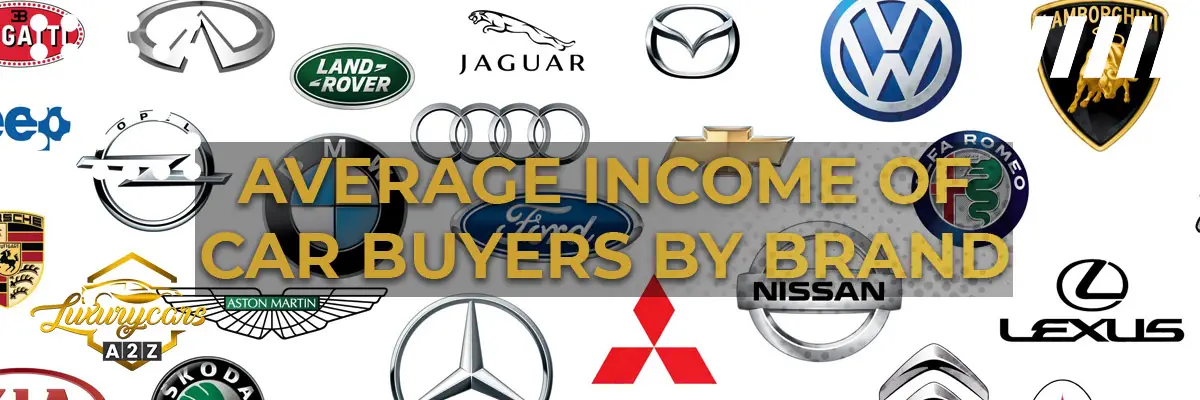Buying a car is a serious investment and not everyone is able to afford it. This means that some people are keen on buying economy-level used high-mileage cars while others are able to buy dozens of cars at once. This means that the base income between buyers is incredibly wide apart, and is also the subject of this article.
Luxury executive German car brands like BMW, Audi, and Mercedes are typically being bought by high-income groups. Audi and BMW are more popular with higher income groups while Mercedes is also more popular with high-income groups but medium-income groups prefer Mercedes over Audi and BMW.
Japanese economy brands such as Toyota, Honda, Nissan, and Mazda are popular with all income groups, but the medium income group seems to be the dominant one. Either way, some brands like Toyota are more popular with high-income groups while Nissan is a preferred choice for lower-income groups.
US brands such as Ford, Dodge, Chevrolet, Jeep, and GMC are typically being bought by everyone. Some brands like GMC are most popular with high-income groups while brands like Chevy and Dodge are preferred by lower-income groups.
More than 50% of Audi buyers are from high-income groups which means that lower and medium-income Audi customers don’t even make half the total amount. The disparity is even greater with BMWs because they are predominantly being bought by high-income households up to 60% to be exact.
Mercedes is popular across the board, but most customers are high-income, about 40% of them. The Volkswagen brand was founded to be the car brand for the masses and that is why it is even called Volkswagen (Cars for the people). That is why Volkswagens are being bought by all three income groups, but the high-income group still buys more VWs than the other two.
Japanese economy car brands – Toyota, Honda, Nissan, Mazda
Toyota is a brand that is popular with all three income groups which means that all three of these individually make up around 30-35% of the total amount. Honda models are mostly being bought by medium income groups which means that more than 45% of all Honda customers reside in the medium income group.
Nissan is the most popular Japanese economy brand among lower-income groups, but medium and low-income groups buy more or less the same amount of Nissan models. Mazda customers are predominantly medium-income individuals which means that they also make up more than 45% of the total amount of customers.
US automakers – Ford, Dodge, GMC, Chevrolet, Jeep
Ford is one of the best-selling brands in the US for a while now and most Ford customers reside in the medium-income group, up to 40%. GMC models are the preferred choice for higher-income groups, but the differences between low and high-income GMC customers are not all that different. This means that medium-income groups are not all that interested in buying GMCs.
Dodge models are typically being bought by low-income groups, medium-income groups come second while high-income households buy the least amount of new Dodge models. Chevrolet is really similar to Dodge, but they sell more models overall. Jeep is the preferred choice for medium-income households while high-income households don’t really buy all that many Jeeps.
High-end supercar and luxury car brands – Ferrari, Lamborghini, Porsche, Bentley
Ferrari only sells to high-income households, not by will, but because low-income households can’t afford a Ferrari while medium-income households are almost as same as low-income households. Lamborghini models are 100% being bought by high-income households which means that medium and low-income households don’t even buy used Lamborghini models.
Porsches are actually being bought by lower-income households, but these are mostly high-mileage cars bought by enthusiasts. Either way, Porsche models are being sold in all three groups, but the high-income household buys the largest amount of Porsches, so much so it can’t even be compared. Bentley is also one of those brands that are exclusively being bought by high-income households.
FAQ Section
Do rich people only buy luxury cars?
Contrary to popular belief, rich people aren’t the only ones buying luxury cars. Luxury cars are typically being bought by all three income groups. The difference here is how many non-rich people buy brand-new luxury cars outright. Medium income households do buy luxury cars from new, but most of them are being leased or financed.
Low-income households do buy luxury cars, but most of them are used models with acceptable running costs. The only low-income customers that dare to buy high-maintenance cars are typically enthusiasts and people who know their way around mechanical work.
Which cars do rich people drive?
Rich people prefer practical SUVs made by premium brands, but many of them drive ordinary cars such as the Ford F-150 or the Toyota Corolla. Most people think that rich people only drive luxury cars, but the reality is that the two most popular brands for rich people are Toyota, Honda, and Ford.
When it comes to luxury cars, rich people buy sedans such as the Mercedes Benz E-Class, the BMW 5-Series, the Audi A6, and the Lexus RX 350. Most of these people can afford much more expensive cars, but most of them settle for less. Only a small portion of rich people truly drive high-end executive luxury cars such as Ferrari, Lamborghini, Porsche, or Bentley models.
Why do people buy luxury cars?
People buy luxury cars because they want to feel accomplished and also want to enjoy the highest levels of comfort and technological supremacy on a daily basis. Luxury cars are made for people who spend a considerable time on the road and this is where luxury cars make the most sense.
If you are rarely driving your car, it makes little to no sense to buy a luxury car. However, if you are someone who often drives long-distance journeys, a luxury car is the best choice to make. It is true that most of these depreciate rapidly, but that comes with the territory.

